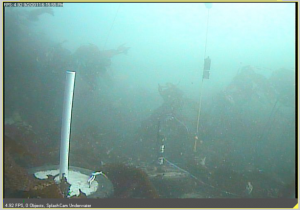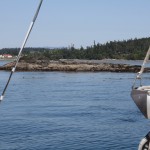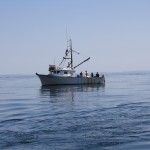
CPOD stand, hydrophones, and Vemco receiver
In collaboration with The Whale Museum, including Research Curator Stefan Bräger and Board member Jason Wood, the fall Beam Reach class has been studying fish and porpoises from the Lime Kiln State Park lighthouse. We’ll be posting results as they accrue, but for now this screengrab shows new instruments from the perspective of the Beam Reach underwater video “Splashcam.” On the left is a stand for 3 CPOD porpoise click detectors (now deployed) provided by Jim Thomson of UW/APL; in the middle are cleaned up hydrophones; on the right is a Vemco fish tag receiver deployed as part of a project led by UW’s Tom Quinn and NOAA’s Kurt Fresh.
The fall class has been surveying the ocean near Lime Kiln for harbor and Dall’s porpoises, monitoring the underwater camera for fish, measuring water properties, and sampling the plankton.  Surprises have been seeing seals and salmon swim by underwater just outside the kelp adjacent to Lime Kiln Point.
Read More
Thanks to a calm weather window and the on-going support of collaborators at the University of Washington and NOAA/NWFSC, we were able to re-deploy two fish tag detectors along the west side of San Juan Island in the first days of 2010. We plan to re-deploy a third in the first quarter of 2010. Stay tuned for a separate post summarizing what fish were detected in the last year or so. In the interim, here are some notes and photos from the field work.
Saturday 1/2/10:
During a hydrophone maintenance dive, Jason Wood and I deployed a new Vemco fish tag receiver (VR2W SN#100905) at Lime Kiln lighthouse. We supported the receiver on doubled crab pot line with a salvaged WDFW float (#3398) and anchored it with about 10 liters of concrete in a paint bucket with rebar/PVC legs. A length of chain embedded in the concrete served as an attachment point for both the receiver mooring (clipped on with a taped SS carabiner) and a tether which was tied to the first hydrophone stand.
The Lime Kiln mooring location is about 30m west of the iron bar near the high tide mark adjacent to the SW corner of the lighthouse. The mooring anchor depth is about 10m.
The highlight of the dive was Jason finding the old VR2W (SN#100914). After we had been led astray by an old yellow line, I was pretty sure we were in the wrong spot and wouldn’t have enough air to search for the old mooring. Yet we had to be close because we had encountered one of the old hydrophone stands whose pair should have been within about 10m. I was thinking about whether the old hydrophone stand might have been moved by the pesky Lime Kiln currents when Jason waved in front of my face. I looked up to see him smiling around his mouthpiece, the algae-encrusted old mooring in his grasp. It was a cinch to raise it with the lift bag and the exfoliated kelp hardly slowed our return to shore.
The VR2W looked great and the red light was confirmed still flashing once uncovered at the lighthouse picnic tables. The float was pretty overgrown with algae and the indelible ink was no longer legible.

Orcasound mooring ready to deploy
Sunday 1/3/10:
While the leaded line tethering the Orcasound VR2W to shore was intact as recently as NN months ago, when we looked for it late last night we found only a short section still attached to the intertidal eyebolt. Luckily the other end was found only a few meters away, pinned under a boulder by 10 cm of gravel. The remainder was entangled in nearshore subtidal rocks, but I managed to tease it out by wading around. I was able to wade to where it was attached to a braided nylon line. There I attached a crab pot float and then re-secured the leaded line to shore.
This morning, Liam helped Val and I pick up the float and back away from shore while taking up the nylon line. The mooring came up fine (though a thicker line for that concrete weight would be easier on the hands) and the red light on the VR2W (SN#100913) was still flashing!
After laying out the new hydrophones (to ensure we didn’t overlay the new Vemco tether), Jason paid out some extra slack in the leaded line. I reattached the nylon line to the leaded line and we drew this longer line tight above the water and maneuvered Cat’s Cradle until we had a clear path straight offshore through the kelp. I attached the new VR2W (Serial Number 100912 moored on the line/float from Lime Kiln recovered yesterday) to the SS hoop in the concrete mooring weight, lowered away, and Liam helped me slip the line. It was pretty slick and fast. It should be interesting to see how the leaded line fares this next round.
The Orcasound mooring location is about 30m offshore of the lowest eyebolt (latitude = 48.55823212, longitude = -123.1737158; UTM y = 5378363, UTM x = 487182). The mooring anchor depth is about 7.7 meters below mean zero tide level.
Here is a spreadsheet that lists all Beam Reach deployments of Vemco receivers:
http://spreadsheets.google.com/ccc?key=tm3KyXdwdOkXl2CWRrVTUww
Read More
On 6/27/09 Val and Jason deployed another Vemco fish receiver at the mouth of False Bay in a depth of 26 feet at 14:22 (should have been ~ 0.16 tide at the time). The location was 48 degrees 28.748 N and 123 degrees 04.411. This location is just off the small island in the mouth of the bay. The serial number of the unit is 100910.
While we were there, a boat with a banner reading ‘Fish Research’ was also present. In talking to them, they told us they were in the process of removing old derelict fishing gear. The name of the vessel was Bet-Sea and had the numbers 785 and 53661 on it. We also spotted this same vessel off False Bay during the Spring 09 quarter.
Read More
Reid Harbor – Snug Harbor
After an efficent morning chore period, we had a long discussion of our current scientific methods and how they need to be changed and improved.  Jason also began to examine the OrcaMaster data set.
In the afternoon, we sank a Vemco receiver in front of Val’s house to pick up the pings from the salmon experiments. The Vemco was deployed at 14:45 at 48, 33.7 and 123, 10.81 in around 10 meters of water. The serial number was 100913.
We did a quick drill with the hydrophone array and recorded the noise of the Gato Verde at 4 knots and varying speeds below as it slowed down. We did a quick man overboard drill with a hockey helmet that we’d found and then spent the early evening learning how to motor around in the dinghy. After a filling dinner, everybody worked through the evening. Peter and Val analysed some of the data we took on the Gato Verde’s noise levels and found some interesting results that will need further experimentation.
Read More
We’ve had a full, exciting day today, a perfect Beam Reach day. I woke a bit later than usual, rolling out of my sleeping bag at 7:50 and wandering into the kitchen to find that almost everyone had already eaten. Jason and Bubbles, his traveling sourdough starter, had made lovely sourdough pancakes.
Our morning meeting turned into an extended, incredibly helpful, strategy session. The conversation, led by Val and Jason, flowed smoothly and ranged from the last bits of research we need to complete for our proposals, to amendments to our data sheets and data collection systems to beginning to practice our analysis. I don’t know about the others but I ended up with two pages of notes and a long list of new things to address or research. About half way through, we decided to “make like plankton,†drifting from Stuart Island, south down Haro Strait, listening to various hydrophones all the while. We were so engaged that we almost, but only almost, worked past lunch.

Our morning meeting in the sunny cockpit
In the course of “making like plankton†we came across some interest flotsam. I asked for the definition of flotsam while writing this and Val promptly answered, “The things you find at garage sales.†It is actually, Todd tells me, the things you find floating in the water. Anyway, today we came across a hockey helmet, a construction hardhat and a circular piece of polystyrene (Styrofoam).
We had an equally busy afternoon, sinking a receiver in front of Val’s house to pick up the pings from transmitters put in salmon. Using an array (pun intended) of ropes, tapes, weights and boats, we managed to sink a cement block attached to the receiver and anchor it to land. As we left, we did a quick drill, pulling out the hydrophone array, as quickly and neatly as possible.
We were just beginning to relax again when Todd yelled, “Man overboard!†There was a great deal of running around without a clue where to turn, trying to decide who would keep their finger pointed at the “man†overboard. This was additionally confusing because for the first few seconds, none of us could see what was supposed to be the “man.†Hannah tossed the man overboard pole like a javelin and if it had actually been a person in the water, they probably would have been impaled. The hockey helmet, our “man†was successfully rescued and we proceeded into Mitchell Bay.
I had just gone to pull out my laptop and start work on the to-do list I generated this morning when Todd called us together and began dinghy training. Erica and I went first as the night’s cooks. It was like learning how to drive all over again only backwards, all with one hand and out in the wonderful, open blue.
The reason I wanted to blog about this day in particular was mainly an idea I had just before dinner while dicing garlic to fry with zucchini. It’s the “Man Overboard†thing. Not only did I feel like today was a bit of a continuous “Man Overboard†drill, in a good, thought-provoking, keep-you-on-your-toes kind of way, but I’ve sort of come to decide that all of Beam Reach is a bit like a “Man Overboard†drill.
It presents challenges that are usually unexpected, a bit nerve-wracking, and have an enormous payoff, if successful. All of our Beam Reach overboards seem daunting and confusing at first, but with helpful direction, good judgments, reliable instincts and hard work, we can complete the rescue successfully.
Read More
Today Val and Scott re-deployed a Vemco VR2 fish tag receiver at Lime Kiln State Park. This receiver, provided for this pilot study to Beam Reach by Fred Goetz, will help marine scientists understand how juvenile and adult salmon use the San Juans, in addition to any other passing fish that have been “tagged” (surgically-implanted) with 69 kHz acoustic tags. We at Beam Reach are most interested in the behavior and distribution of adult Chinook salmon, and secondarily any other potential prey of the endangered southern resident killer whales.
58724
58727
The photos above show the mooring prior to being snorkeled down to the pier block that remained from the previous deployment (last November).
Two other VR2s have been provided by Kurt Fresh of NOAA. (Their serial numbers are: 100910; 100913.) One will be deployed on the west side of San Juan Island; the other will be placed near Cattle Pass.  We’ve mounted them on short (~2.25m) mooring lines (1.25cm diameter 3-strand poly), supported by single yellow shrimp pot floats (see below). The base of the receivers will be ~0.75-1m above the bottom. The floats will be ~1m above the top of the receivers. The mooring weights are either ~25kg concrete slabs (35cm x 35 cm x 15 cm; see below) or paint buckets filled with cement. Both types of weights have metal hoops or chain for attaching the mooring line and for lowering during deployments from a boat.


Data and analysis from these deployments will be documented in the Beam Reach science wiki
Read More
 Last Sunday (11/09/2008), Jason Wood and Scott Veirs deployed a receiver that can detect and record the signals emitted by acoustic tags implanted surgically in migratory fish, like the Chinook and chum salmon that southern resident killer whales appear to prefer. The Vemco “VR2″ receiver, provided by Fred Goetz through a collaboration with UW Fisheries, was deployed during a scheduled maintenance dive on the hydrophones at the Lime Kiln lighthouse. The plan is to retrieve the VR2 in early 2009, download any serendipitous detections that may help in the interpretation of the echosounder data (to be presented at the Puget Sound Georgia Basin conference), and then redeploy it for the remainder of the winter (and perhaps the entire year).
Last Sunday (11/09/2008), Jason Wood and Scott Veirs deployed a receiver that can detect and record the signals emitted by acoustic tags implanted surgically in migratory fish, like the Chinook and chum salmon that southern resident killer whales appear to prefer. The Vemco “VR2″ receiver, provided by Fred Goetz through a collaboration with UW Fisheries, was deployed during a scheduled maintenance dive on the hydrophones at the Lime Kiln lighthouse. The plan is to retrieve the VR2 in early 2009, download any serendipitous detections that may help in the interpretation of the echosounder data (to be presented at the Puget Sound Georgia Basin conference), and then redeploy it for the remainder of the winter (and perhaps the entire year).
The dive went well and lasted from about 11-12am. We enjoyed visibility of about 20m and pleasantly calm seas (it was very rough on Saturday when we initially planned to dive). We cleaned and secured the intertidal hydrophone and echosounder cable protectors, checked the VR2 mooring for buoyancy, and then followed the hydrophone cable to the two hydrophone stands (cement-filled paint-buckets with a broad tripod of embedded rebar). The VR2 was deployed 3m NW of the southern hydrophone and its mooring anchor was tethered to that hydrophone stand’s embedded chain and one of its rebar legs.
The VR2 mooring had a total height above bottom of 2m, with the receiver hydrophone oriented upwards about 1.4m above bottom. Since the mooring was deployed in 9m of water when the tidal height was ~2m, the depth of the receiver is about 6m below the tidal datum (0m). The mooring consists of a ~2m length of 1/2″ 3-strand polypropelene line connecting a ~3kg buoyancy crab float (used in lieu of an incompressible trawl float since minimal compression is expected at this depth), the VR2 (cabled-tied through and around the strands), and a stainless steel threaded shackle (bowlines at both ends). The shackle connects to a loop of 3/16” plastic-coated wire rope that extends through a pier-block (via a 3/4 inch hole drilled through center line). The loop is secured with a clamp and is attached via sheet-bend to the ~4m-long tether (same type of line). All knots’ tails are secured with electrical tape. The float is marked with UW Fisheries research and Scott’s cell phone number.
Detailed photos of the mooring, including closeups of each component are available in the Beam Reach gallery.
Read More








 Twitter
Twitter LinkedIn
LinkedIn Facebook
Facebook